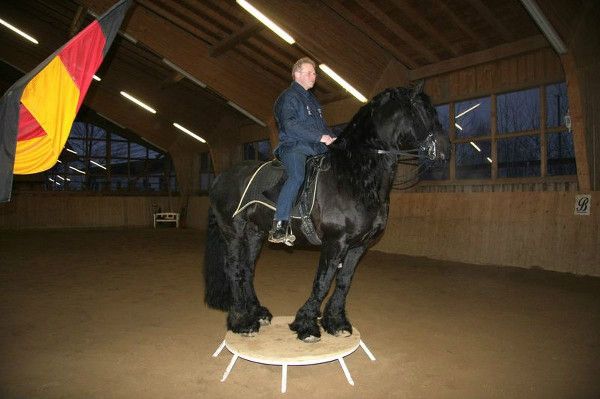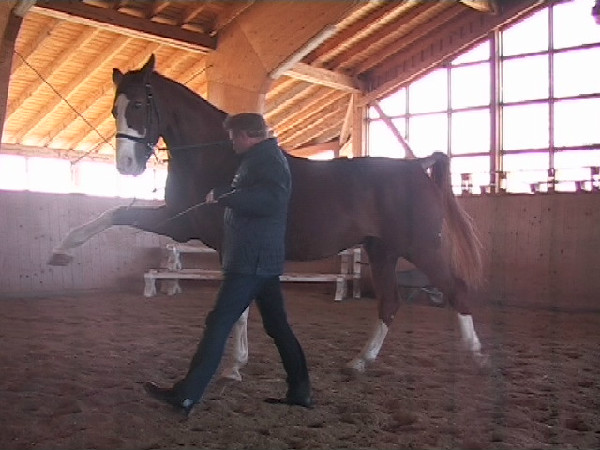Ralf Schmitzer: Classical Dressage and Respect
by Heidi Longaberger
Classical dressage master and trainer Ralf Schmitzer approaches my horse Thomas with a look of amusement and affection, offering him a cookie for a job well done. We have just spent the last hour working on my balance and position in the saddle, while my horse pranced, danced, rolled his eyes and finally relaxed. Ultimately, Ralf’s keen eye in making the slightest changes to my seat brought us to willing, balanced forward movement with suppleness and moments of true self-carriage.
Ralf and Martina Schmitzer opened their Gstadt / Sulzberg, Germany, based riding school called the Gstadter Hof in 1992. After being part of the show scene for many years, Martina and Ralf sought a solution to the physical and psychological problems that they witnessed in the performance horse. The Schmitzers made the bold decision to no longer participate in shows. Now, they concentrate on teaching and training based on the classical principles of the original dressage masters.

Ralf Schmitzer
Heidi Longaberger for Equitrekking: What attracted you to dressage?
Ralf Schmitzer: In the beginning I was mainly a jumper, and I loved going on trail rides. Dressage riding was a necessity but I did not consider it to be fun. I used dressage to have a horse that was easier to ride and steer. Then I stumbled upon classical dressage, and it became clear to me that biomechanics and an understanding of anatomy are the keys. With them you can work with your horse to achieve and maintain its health, joy and brilliance. My main goal today is to find a way to work without pressure and coercion. I believe it is the only way to truly work with a horse. Especially important are the rider and his/her body influence, as well as the mouth of the horse.
Equitrekking: You were involved in competitive dressage, but at some point you sought a different way to train and ride, which is somewhat unique in the competitive horse world. Can you elaborate on when, why and how you began to pursue classical dressage techniques?
Ralf Schmitzer: What prompted the change to classical dressage was a horse that I had in training. He was considered to be unrideable. All of the tried and true methods did not work. I had to rethink the whole system and what I had learned in the past. I stumbled across some literature about classical riding and also met a classical master. After some studying, it became very clear to me that there was a big difference between the riding I had been taught and the classical method — less pressure, less stress, building trust, being more tolerant and willing to compromise. And that makes the horse willing and able to work with me.
Ralf Schmitzer and friends riding Andalusian stallions
Equitrekking: I remember the first few rides I took with you. We worked only at the walk and on my position, and I felt like we were hardly making any progress. But suddenly, by the end of three lessons, my horse was moving with much more ease and balance. Can you elaborate on your techniques?
Ralf Schmitzer: Most training today is about teaching the rider shortcuts and the fastest way to get some kind of result. After all, “Time is money.” To develop a long-term relationship with your horse and to keep your horse happy and healthy, you need time, patience and calmness.
If you can use your body in a way where you have clarity about your center of gravity, and if you can use your center of gravity with intention, then you have the ability to influence your horse. This influence can now happen without force, without coercion, and without putting the horse “in a frame.” If you can work without force, you then can influence the horse’s body in a positive matter and work according to the biomechanics.
It is of utmost importance to learn how to feel and to observe reactions of your horse based on your actions. All of this takes a lot of time. I believe that long-term results count, not short-term ones. The speed of learning and training is based on the horse and the ability of the rider to feel the horse.
Equitrekking: What types of horses do you have?
Ralf Schmitzer: We currently have several Friesians (including a stallion), some Spanish horses, German Warmbloods, Arabians and several ponies (a Welsh Pony, a German Riding Pony and a Norwegian Fjord) at our barn. We own most of them, as we have a very limited boarding operation. All of our horses are used for lessons.
Equitrekking: Do you work with any breed? Are there some breeds that are your favorites?
Ralf Schmitzer: The breed does not matter to me. I like working with any breed and enjoy dealing with the idiosyncrasies of each breed. Working with different breeds actually makes it more interesting. Personally, I have a soft spot for the Friesians and Spanish horses.
.jpg)
Ralf Schmitzer’s stable in Germany
Equitrekking: Can anyone come to your facility for riding instruction or training? If someone is traveling through Germany, can they stop for some lessons?
Ralf Schmitzer: Yes! We welcome anyone to take lessons at our facility. We also work with riders who trailer in with their own horses. All you have to do is ask, and we are happy to help you. I am especially happy and excited to work with people from other countries who want to learn about my teaching and training methods.
Equitrekking: Have you trained other trainers to use your methods with their horses?
Ralf Schmitzer: Our gentle method of training and riding is not very common in Germany. Therefore, we often have other trainers who want to come and learn from us. They are interested in our philosophy and biomechanical principles. One of the instructors whom we have trained teaches successfully in Switzerland. In the United States, we have Simone Windeler and TJ Sommerfield as certified instructors teaching our methods.
Equitrekking: You start both horse and rider out with what many would consider to be advanced movements and equipment. For example, many of your students start out using the double bridle. The piaffe, which may be considered an advanced movement, is introduced to the horse early on. Can you explain your theory on this?
Ralf Schmitzer: I think that proper bit fit and placement is very important. You can create a lot of pressure and pain in a horse’s mouth, which will lead to resistance. I believe that the mullen mouth pelham is the best bit for a precise communication with your horse. This bit allows precision in the placement of head and neck without creating a blockage in the mouth. In addition, since the pelham is considered a more severe bit, riders tend to ride with a lighter hand, and that is a welcome side effect.
I use piaffe as a tool. Since there is very little elasticity in piaffe, it is gentle on the joints but allows me to work the horse well over its back. In addition, it allows me to move the horse’s center of gravity towards the haunches and to develop a better, stronger hind end with carrying power.

Ralf Schmitzer training the Spanish Walk
Equitrekking: Is there specific equipment that you recommend for achieving a good riding relationship with the horse?
Ralf Schmitzer: I prefer a well-fitting dressage saddle that does not block the back of the horse, does not pinch the shoulder, and overall sits in good balance. As I mentioned, the mullen mouth pelham is my preferred bit, as it is the most precise bit I know. I do not believe in any helper reins, side reins, etc. If I use other tools, such as long lines, I make sure that they fit well and don’t create pressure in any way.
Equitrekking: What’s the funniest or most unusual thing that you have encountered when training horses or people (no names!)?
Ralf Schmitzer: As I tend to use some unusual patterns, there is often confusion for the rider on how to execute the pattern. We have had situations where we needed several people, cones, drawings, etc., to help riders understand the patterns I would like them to ride. We are not always successful.

Heidi Longaberger with her horse Thomas and Ralf Schmitzer
Equitrekking: What is your view about the future of dressage and horsemanship? I think most people, both competitive and casual riders, are always seeking the best way to achieve harmony with their horses. However, there are so many conflicting training methods.
Ralf Schmitzer: Quite frankly, I am worried about the sport of dressage. Horses today are trained quickly and without much consideration for their bodies. Seeing quick results seems to be the main goal. I do hope that classical dressage will survive and people will understand that proper training takes lots of time and patience.
Surely there are many ways to train a horse, often based on what you are trying to achieve in the end with your horse. I think the health and happiness of the horse are paramount in training. Any training method that uses this as its base makes sense to me. Unfortunately, in our time we value speed, money and fancy movements – not a good way to properly train a horse.
You can reach Ralf Schmitzer at www.reitschule-schmitzer.de/en/, or at his address: Schul- und Ausbildungsstall Schmitzer, in Klassischer Reitkunst, Gstadter-Hof 2, D-87477 Sulzberg. Tel.: 08376/1664 or Fax: 08376/976504
Heidi Longaberger is an information professional, researcher, and writer who happens to be owned by a horse.




